Asp
Vipera aspis
It was the symbol of royalty in Egypt, and its bite was used for the execution of criminals in Greco-Roman times.
Advertisement
Asp Scientific Classification
- Kingdom
- Animalia
- Phylum
- Chordata
- Class
- Reptilia
- Order
- Squamata
- Family
- Viperidae
- Genus
- Vipera
- Scientific Name
- Vipera aspis
Read our Complete Guide to Classification of Animals.
Asp Conservation Status
Asp Facts
- Prey
- Rodents, birds, lizards
- Group Behavior
- Solitary
- Solitary except during mating season
- Communal Dens
- Fun Fact
- It was the symbol of royalty in Egypt, and its bite was used for the execution of criminals in Greco-Roman times.
- Litter Size
- 5-12
Queen Cleopatra reportedly committed suicide by letting herself be bitten by an asp.
The asp is a venomous snake native to parts of Europe. Although this reptile has long been associated with the culture of ancient Egypt, historians believe the Egyptian symbolism referred to a horned viper or a species of cobra. Asps are not native to Egypt, and their triangular heads slightly resemble those of cobras. These snakes live in many forested areas of Europe, and their bites can be deadly.

4 Amazing Facts About Asps!
- It has long, hollow fangs it can rotate independently.
- Although most vipers are nocturnal, the asp is a diurnal predator.
- Asp snakes are ambush predators.
- Although associated with Egyptian symbolism, asps are not native to Egypt.
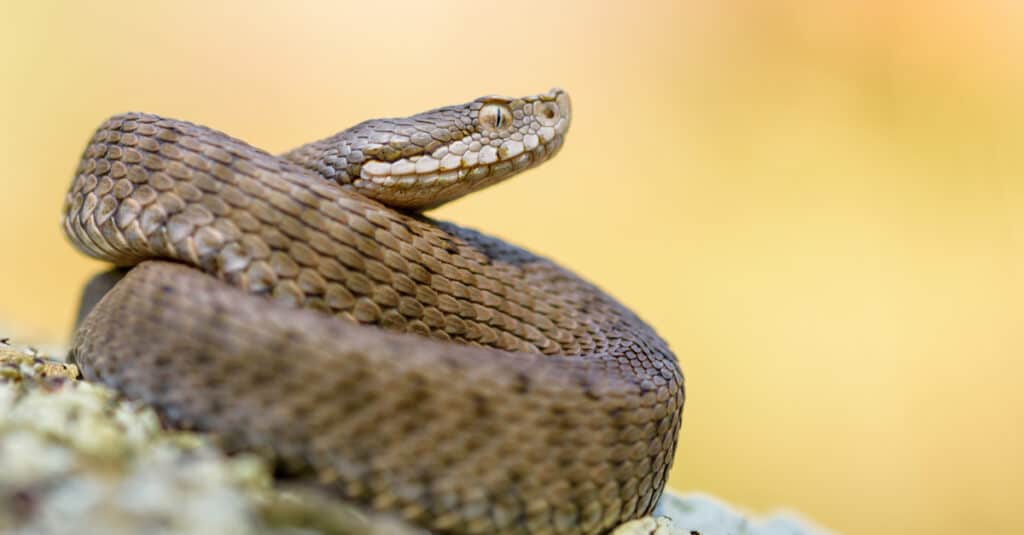
Asps are ambush predators.
©Pedro Luna/Shutterstock.com
Scientific Name
The scientific name of the asp is Vipera aspis, which comes from the ancient Greek word “aspis” meaning viper.
Other common names for this snake are the asp viper, aspic viper, European asp, European viper, and Jura viper. Historically, the word asp was used in reference to any venomous snake.
5 Types of Asps
There are five subspecies of the asp that are recognized, and differentiated by their habitats, size, and appearance in color and markings. They are:
- European asp (Vipera aspis aspis): This subspecies is found in several countries, including France, Italy, Switzerland, Spain, and Germany.
- Black asp (Vipera aspis atra): The black asp is present in Switzerland, French, and the Italian Alps.
- Central Italian asp (Vipera aspis francisciredi): As its name indicates, this subspecies is in Central Italy.
- Southern Italian asp (Vipera aspis hugyi): This asp lives in the south of Italy. Vipera aspis montecristi was determined to be synonymous with this subspecies.
- Gascony asp (Vipera aspis zinnikeri): This subspecies can be found in the French region of Gascony, Andorra, and Spain.
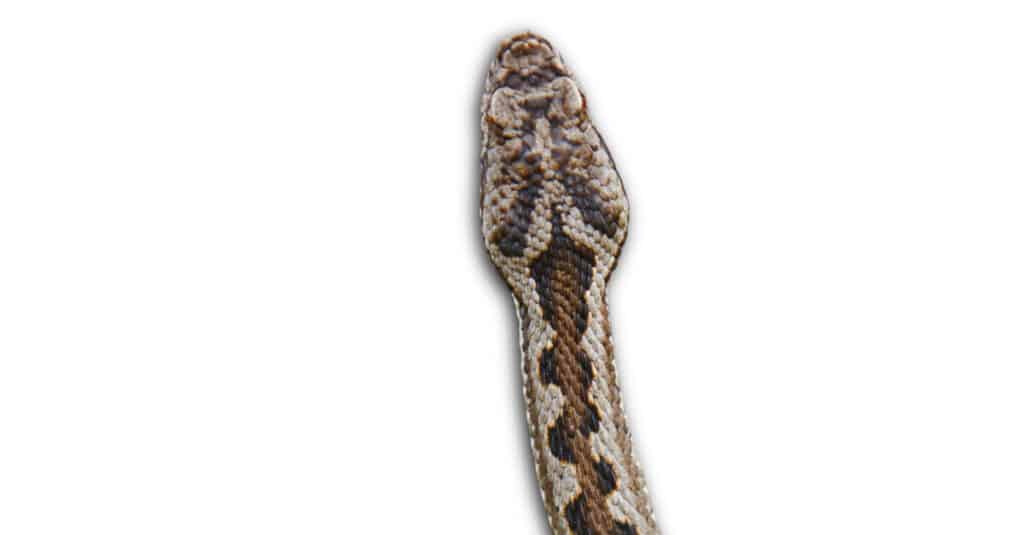
There are five recognized subspecies of the asp.
©ABB Photo/Shutterstock.com
Similar Animals
Evolution and Origins
The asp is a member of the Vipera genus of palaearctic vipers and Eurasian vipers. Fossil evidence of the oldest of these Old World vipers, Vipera antiqua, dates to 22.5 million years ago in southern Germany.
In ancient Rome and Egypt, the asp was a symbol of royalty. Queen Cleopatra reportedly committed suicide by letting herself be bitten by an asp. Modern historians say it was more likely that she took an overdose of sleeping potions, but the legend persists.

In ancient Egypt, the asp was a symbol of royalty.
©leoks/Shutterstock.com
Appearance
The asp has certain characteristics that make identification of this species easy. It has a broad, triangular head that almost looks like the head of a cobra. It also has an upturned snout.
Its colors are also distinctive. Males are usually gray with a slight zig-zag pattern of darker colors on their backs. Females may be gray, brown, or orange with similar dorsal markings.
Size is another way to identify this snake. The asp is a long snake that can reach more than 3 feet in length. Its long, curved fangs are a key point of identification.
Their fangs are hinged, hollow, and rotatable. They can rotate them independently or together, which allows them to conserve venom. Asps take a long time to renew their venom once they use it. With a long lifespan of up to 20 years, it’s important to use their poison only when necessary.
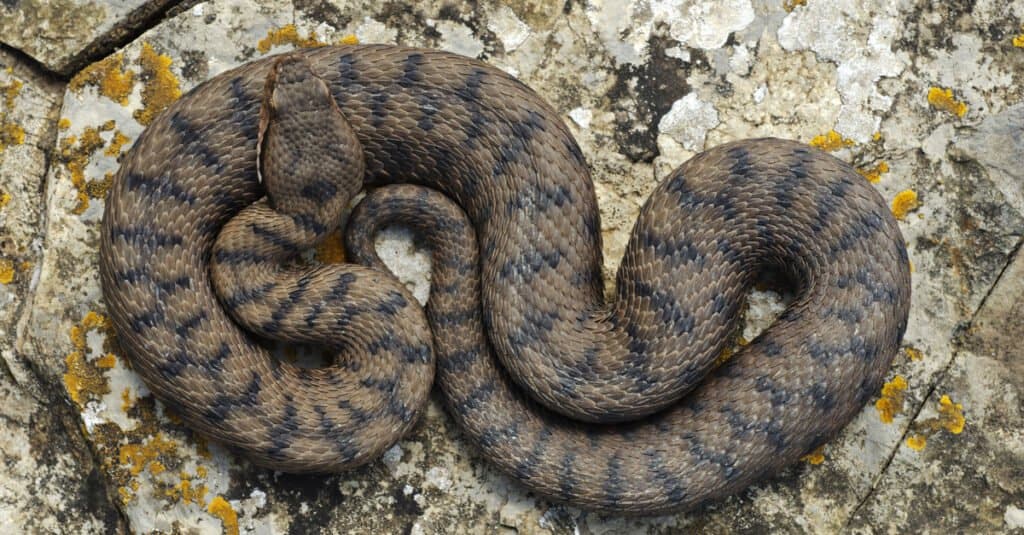
Male asps are typically gray with a darker zig-zag pattern on their backs.
©Marco Maggesi/Shutterstock.com
Behavior
The asp snake is diurnal. It spends its day hunting for small animals and uses an ambush hunting style, hiding in vegetation and shrubbery until it senses prey nearby. When it detects an animal moving past its location, the asp strikes with its venom.
At night, it retreats to a burrow. It is unusual to see an asp at night.
If you meet an asp, do not approach it. Back away slowly, and wait for the snake to move away. This snake is not aggressive, and it is likely to simply run away if you don’t agitate it.
Asps have a characteristic warning sign. They curl their tail into a circle, stretch the front part of their body upward, and then hiss loudly before they strike.
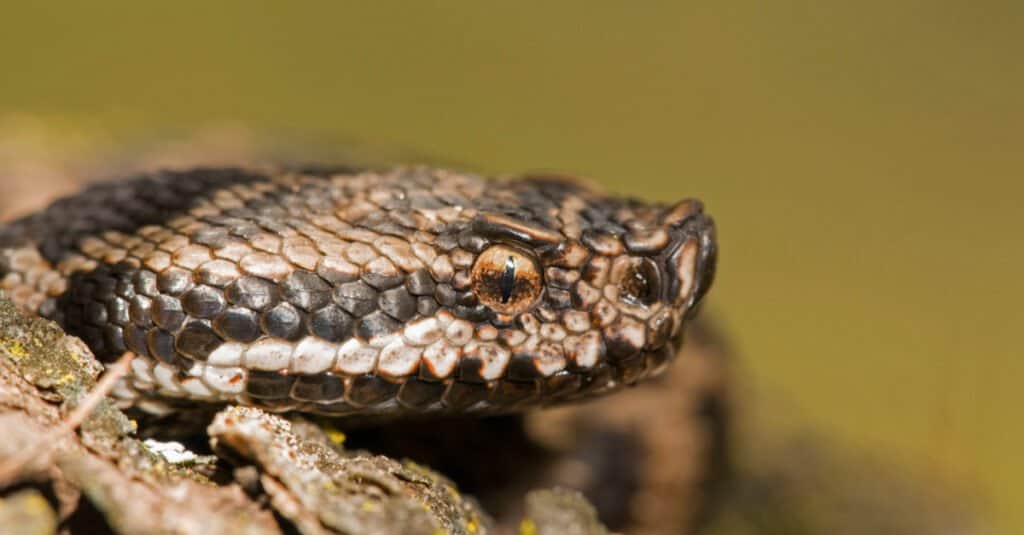
The asp spends its day hunting for small animals.
©Federico.Crovetto/Shutterstock.com
Venom: How Dangerous Are Asps?
This snake is highly venomous. The asp’s bite is very painful, and untreated bits can be fatal.
Symptoms of an asp bite begin with sharp pain, then swelling and bruising occur. The venom can cause a rapid degrading of blood vessels, which leads to issues with vision.
It’s important to note, however, that asps typically deliver a “dry bite,” which is a bite that doesn’t inject poison. While very painful, this is not life-threatening. Only a very frightened asp will deliver a venomous bite.
Facts About Snakebite
If an asp bites you, seek medical attention immediately. Antivenoms exist for their venom, but untreated bites can be dangerous.
Follow these steps:
- Keep the victim calm. Getting agitated will increase the heart rate and worsen the problem by circulating the venom more rapidly.
- Remove anything that might constrict the area where the bite happened.
- Use a bandage and splint to immobilize the limb.
- Do not allow the victim to eat or drink anything, even water. It’s important to keep their metabolism low.
- Do not cover the bite. Clean the wound location with an antiseptic.
- Get the victim to a hospital as soon as possible. Using an antivenom serum is the only way to treat asp bites.
Do not:
- Apply ice to the bite.
- Cut or slice the wound to release the poison.
- Suck the venom out with your mouth.
- Use suction devices to suck the venom out of the puncture mark. These devices are ineffective because their fang injects the venom deeply into tissue.
Even a full bite from a venomous snake is only fatal in a few cases. With proper first aid and antivenom serum, full recovery from snakebite is possible.

Asp venom can cause severe pain, swelling, and tissue damage.
©joloei/Shutterstock.com
Habitat
Asps are native to native to Andorra, France, Germany, Italy, Slovenia, Spain, and Switzerland. They thrive in warm climates that are exposed to the sun for many hours of the day. Their preferred habitat has thick vegetation for cover. Asps like to live near streams and don’t typically extend their range into mountain heights.
The asp’s habitat can vary according to where you find it. It is primarily found in hilly areas, scrublands, sunny slopes, and lower mountain slopes. You can find it in any wooded area, especially at the edge or border of woodland.

The asp thrives in warm climates exposed to the sun.
©Matteo photos/Shutterstock.com
Diet
Asps are carnivores and predators. Their diet includes rodents, small reptiles such as lizards, and birds.
These predators use an ambush hunting method. They wait in a hidden location for prey to walk past. When they sense prey nearby, they reach out and bite it with their fangs.

Asps are carnivores and feed on rodents as part of their diet.
©Carlos Aranguiz/Shutterstock.com
Predators and Threats
Humans provide the biggest threat to asps in the form of habitat loss from land development for the agricultural industry and increasing urbanization. They are also at risk of being caught to be sold as pets and can be killed when on or near roads.
Reproduction, Babies, and Lifespan
The asp’s breeding season is in spring, April and May, each year, although it’s not uncommon for mating to occur in late summer. Gestation is about 3-4 months, then females give birth to 5-12 live young. These snakelets, 4.7-8.6 inches long at birth, are immediately independent and can hunt once they are a few days old.
The asp has a long lifespan of 15 to 20 years in the wild.
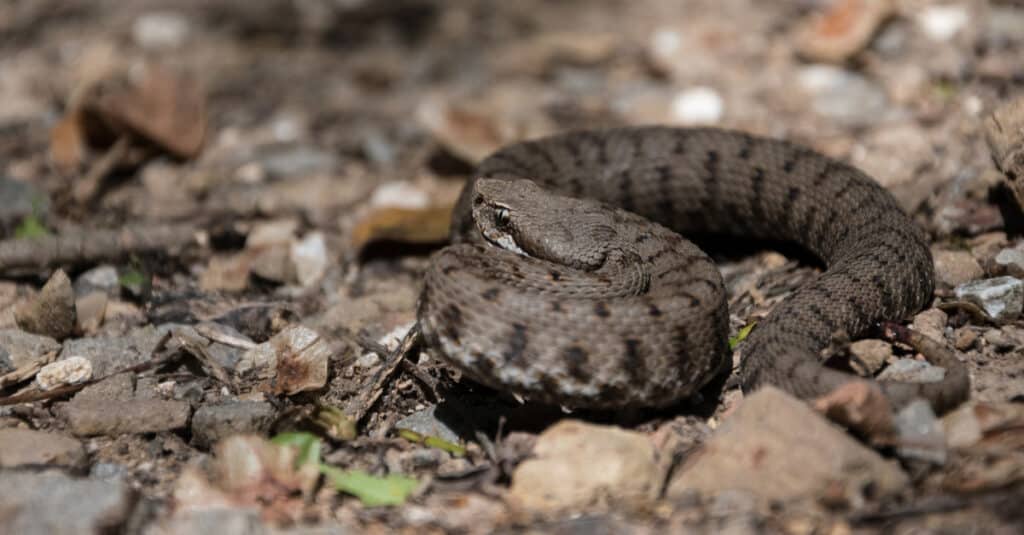
Juvenile asps are able to hunt a few days after birth.
©Claudio Pardo/Shutterstock.com
Population and Conservation
The asp is classed as Least Concern by the International Union for the Conservation of Nature (IUCN). It has a wide distribution and a large, stable population. The exact numbers are unknown, however. The asp is protected by the Berne Convention on the Conservation of European Wildlife and Natural Habitats, also known as the Berne Convention.
Specific subspecies of the asp are threatened:
- The European asp is classified as Critically Endangered in Switzerland.
- The black asp is considered Vulnerable.
- The Central Italian asp is categorized as Endangered.

The IUCN’s Red List categorizes the asp as of Least Concern.
©Tobias Arhelger/Shutterstock.com
Asp FAQs (Frequently Asked Questions)
What is an asp snake?
An asp is a type of poisonous snake that is native to parts of Europe. It reaches 3 feet in length and has long curved fangs. An asp is a reptile and a member of the viper family.
What is a black asp snake?
A black asp snake is not a separate species of asp. Some asps are so dark gray that they appear black. A black asp snake is rare to see and very striking in appearance.
What happens if an asp snake bites you?
You will feel sharp pain, swelling, and possible loss of vision. It’s important to get medical help immediately.
How big can an asp snake get?
It can grow up to 3 feet long.
Are asps venomous?
Yes, they are venomous. Their bite is painful and can cause swelling, intense pain, and loss of vision.
How do asps hunt?
These predators use an ambush hunting method. They wait in a hidden location for prey to walk past. When they sense prey nearby, they reach out and bite it with their fangs.
Are asps aggressive?
They are not aggressive. Despite their large size and fierce fangs, most asps will not attack humans unless they feel threatened. In most cases, people are bitten because they try to touch the snake, poke it with a stick or step on it by accident. Always be careful when hiking in the woods. Wear thick, protective shoes and socks, and watch where you are walking.
Where do asps live?
They live in Europe, especially France, Italy, and Switzerland. They prefer a sunny habitat close to water sources with exposure to hours of sunlight. You can find them in most hilly, woodland areas of Europe. Although many people associate asps with Egyptian symbolism, they are not native to Egypt.
How do you know if a snake is an asp?
The main identification marks are the snake’s large size, triangular head, and dorsal markings. It typically has spots in brown, gray, and other dark colors.
What do asps eat?
They are carnivores and predators. Their diet includes small reptiles, birds, and rodents.
Thank you for reading! Have some feedback for us? Contact the AZ Animals editorial team.
Sources
- Live Science, Available here: https://www.livescience.com/54023-vipers.html#
- Iberian Vipers, Available here: http://www.viborasdelapeninsulaiberica.com/description-asp-viper-1.html
- Planet Deadly, Available here: https://www.planetdeadly.com/animals/dangerous-animals-europe
- Animalia, Available here: https://animalia.bio/asp-viper

















